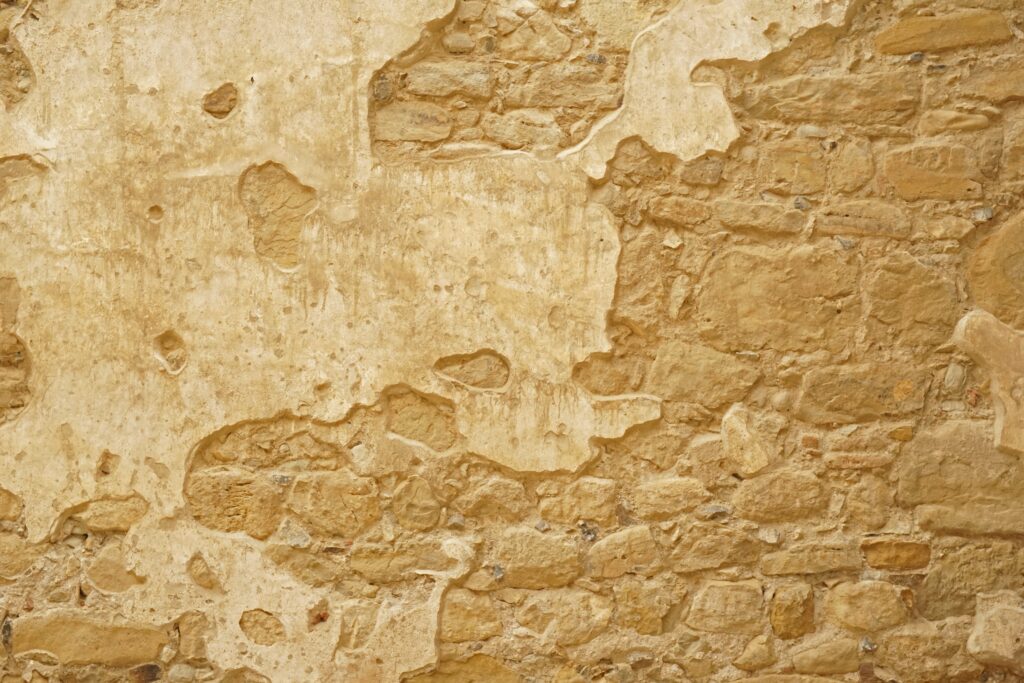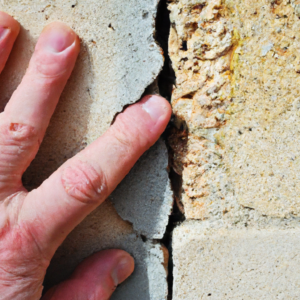Are unsightly cracks in your stucco wall causing you distress? Worry no more! In this article, we will explore the world of stucco crack repair, providing you with valuable tips and techniques to restore your wall’s former glory. Discover expert advice on finding the root cause of cracks, learn step-by-step repair methods, and gain insights into preventive measures to ensure long-lasting results. Say goodbye to crumbling stucco and hello to a beautifully restored facade. Let’s dive into the world of stucco crack repair!
Types of Stucco Cracks
Hairline cracks
Hairline cracks in stucco are very common and often appear as thin, shallow lines on the surface. They are usually caused by the natural drying and settling of the stucco over time. Hairline cracks are typically small and do not affect the structural integrity of the stucco, but they can still be unsightly and should be repaired to prevent further damage.
Settlement cracks
Settlement cracks occur when the building or structure settles due to changes in the soil beneath it. These cracks often appear as vertical or diagonal lines and can be wider than hairline cracks. While settlement cracks may not always be a cause for concern, they should be evaluated as they can indicate potential foundation issues.
Expansion cracks
Expansion cracks are commonly caused by temperature fluctuations. When stucco expands and contracts with changes in temperature, it can create stress on the surface, resulting in cracks. These cracks are typically wider than hairline cracks and may be accompanied by gaps between the stucco and adjacent surfaces, such as windows or doors.
Stress cracks
Stress cracks are usually the result of excessive pressure or stress being applied to the stucco. This can occur due to structural movement, such as settling or shifting of the building, or external forces like impact or vibration. Stress cracks can vary in size and shape, and may require more extensive repairs depending on the severity of the damage.
Spider web cracks
Spider web cracks, also known as map or pattern cracks, resemble a spider’s web with multiple intersecting lines. These cracks can be caused by a variety of factors, including the natural aging of the stucco, improper installation, or underlying structural issues. Spider web cracks are often a sign of more serious damage and should be addressed promptly.
Causes of Stucco Cracks
Temperature changes
Temperature changes, particularly rapid or extreme fluctuations, can cause stucco to expand and contract. This thermal movement puts stress on the stucco surface, leading to the development of cracks. Areas with frequent temperature swings are more prone to this type of cracking.

Moisture damage
Moisture can be a major culprit when it comes to stucco cracks. Excessive moisture can seep into the stucco, weakening its structure and causing it to crack or crumble. Water can enter through faulty flashing, leaky gutters, or even excessive condensation. It’s important to address any moisture issues promptly to prevent further damage.
Settlement of the building
Settlement cracks occur when the building or structure settles, often due to changes in the underlying soil. As the foundation adjusts and moves, it can cause stress on the stucco, resulting in cracks. Proper construction techniques, such as adequate foundation support, can help minimize settlement-related cracks.
Improper application
If stucco is not applied correctly, it can lead to cracking and other defects. Common causes of improper application include inadequate mixing of the stucco materials, improper curing, or improper thickness of the stucco layer. Hiring a skilled and experienced contractor is crucial to ensure proper stucco application.
Structural movement
Structural movement, such as shifting or settling of the building, can put strain on the stucco and lead to cracks. This can occur due to various factors, including soil conditions, aging of the structure, or seismic activity. It’s important to address any underlying structural issues to prevent recurring cracks in the stucco.
Assessment and Preparation
Inspecting the crack
Before beginning any repairs, it is important to thoroughly inspect the stucco cracks to determine the extent of the damage and the underlying cause. This involves closely examining the cracks and surrounding areas to identify any patterns, severity, or associated issues.
Determining the underlying cause
Understanding the cause of the stucco cracks is essential for effective repair. By identifying the underlying issue, whether it be settlement, structural movement, temperature changes, or other factors, you can address the problem at its source and prevent future cracking.

Cleaning the area
Before applying any repair materials, it is important to clean the area around the cracks. This involves removing any loose debris, dirt, or old patching materials. A wire brush or a similar tool can be used to thoroughly clean the surface, ensuring proper adhesion of the repair compound.
Preparing the stucco
To prepare the stucco for repair, the damaged area should be properly prepped. This may involve enlarging the crack slightly to create a better base for the repair compound. Using a utility knife or a chisel, carefully widen the crack to allow for proper application of the patching material.
Tools and Materials
Protective gear
Before starting any repair work, it is important to prioritize safety. Wearing personal protective gear, such as gloves, safety glasses, and a mask, can help protect you from any potential hazards, including dust and chemicals.
Utility knife
A utility knife is an essential tool for stucco crack repair. It can be used to clean and prepare the damaged area by removing loose stucco, paint, or other debris.
Wire brush
A wire brush is useful for cleaning the area around the crack, ensuring proper adhesion of the patching materials. It helps remove loose particles and creates a rough surface for better bonding.
Hammer and chisel
A hammer and chisel are needed for widening the crack in preparation for repair. Carefully chip away at the edges of the crack to create a slightly larger groove that allows the patching compound to adhere properly.

Drill with masonry bit
If the crack is deep or wider, a drill with a masonry bit can be used to create shallow holes along the length of the crack. These holes will serve as anchors for the patching material, ensuring a strong and durable repair.
Stucco patching compound
A high-quality stucco patching compound is essential for repairing stucco cracks. This material is specifically designed to adhere well to the existing stucco and provide a durable, long-lasting repair.
Techniques for Repairing Stucco Cracks
Filling hairline cracks
Hairline cracks can be repaired using a flexible, paintable acrylic caulk or a specialized crack repair compound. Apply a thin bead of caulk into the crack, making sure to fill it completely. Smooth the caulk with a putty knife and allow it to dry before painting over it, if desired.
Repairing larger cracks
For larger cracks, a stucco patching compound is recommended. First, dampen the crack with water to create a better bond between the stucco and the patching material. Then, apply the compound into the crack using a putty knife, making sure to push it in firmly. Smooth the surface with the putty knife, remove any excess compound, and allow it to dry.
Patching deep cracks
Deep cracks may require additional reinforcement to prevent future cracking. After widening the crack, insert a piece of wire mesh or hardware cloth into the groove. This will provide added strength to the repair. Apply the patching compound over the wire mesh, smoothing it out and feathering the edges for a seamless finish.
Dealing with multiple cracks
If there are multiple cracks in close proximity, it may be more efficient to repair them all at once. This involves following the same steps for each crack individually, ensuring proper cleaning, preparation, and application of the patching compound. By addressing all the cracks simultaneously, you can achieve a cohesive and uniform repair.
Matching texture and finish
After the patching compound has dried, it is important to match the texture and finish of the existing stucco. This can be achieved by using a texture roller or a texture brush to create a similar pattern on the repaired area. Allow the texture to dry before applying the final finish, such as paint or stucco color coat, to blend the repair seamlessly with the surrounding stucco.
Step-by-Step Stucco Crack Repair Process
Step 1: Inspect and assess the cracks
Thoroughly inspect the stucco cracks, evaluating their severity, size, and location. Determine the cause of the cracks, whether it be settlement, temperature changes, or other factors. This assessment will help guide the repair process.
Step 2: Clean the area around the cracks
Using a wire brush or similar tool, clean the area around the cracks to remove any loose debris or old patching materials. Ensure the surface is clean and free from any contaminants that could hinder proper adhesion.
Step 3: Prepare the stucco patching compound
Follow the manufacturer’s instructions to prepare the stucco patching compound. This usually involves mixing the compound with water to achieve the desired consistency. Mix only a small amount at a time to ensure that it remains workable throughout the repair process.
Step 4: Apply the patching compound
With a putty knife, apply the patching compound into the crack, ensuring that it fills the entire length and depth of the crack. Press the compound firmly into place, ensuring proper adhesion and eliminating any air pockets.
Step 5: Smooth and blend the patch
Using the putty knife, smooth the surface of the patching compound, feathering the edges for a seamless blend with the surrounding stucco. Take care to create a level surface, free from any bumps or unevenness.
Step 6: Allow the patch to cure
Allow the patching compound to cure according to the manufacturer’s instructions. This typically requires a drying time of several hours or even overnight. Avoid touching or disturbing the patch during this curing period.
Step 7: Paint or finish the patched area
Once the patching compound has fully cured, apply the final finish to the repaired area. This can involve painting the entire wall or applying a stucco color coat to match the existing texture and appearance of the surrounding stucco.
Preventive Measures
Maintaining proper drainage
Good drainage is key to preventing moisture-related stucco cracks. Ensure that gutters and downspouts are clear and functioning properly to direct water away from the building. Regularly inspect and clean these systems to prevent any potential water damage to the stucco.
Sealing cracks and joints
Regularly inspect the stucco for any cracks or gaps and promptly seal them to prevent moisture intrusion. Use a high-quality exterior caulk or sealant that is compatible with stucco to fill in any gaps or cracks. This will help maintain the integrity of the stucco and prevent further cracking.
Regular inspections and maintenance
Perform regular inspections of the stucco to identify any new cracks, damage, or signs of deterioration. Promptly address any issues, whether it be small cracks or larger structural concerns, to prevent further damage and costly repairs.
Addressing underlying structural issues
If the stucco cracks are a result of underlying structural issues, it is important to address these problems to prevent recurring cracking. Consult with a qualified professional or structural engineer to assess and address any structural concerns.
Applying a protective coating
Consider applying a protective coat or sealant to the stucco surface to provide an extra layer of protection against moisture and other damaging elements. These coatings can help prolong the lifespan of the stucco and minimize the development of cracks.
DIY vs. Professional Repair
Advantages of DIY repair
Repairing stucco cracks yourself can save you money, especially for small, manageable repairs. DIY repair allows you to have control over the repair process and timeline. It can also be a rewarding hands-on project for homeowners who enjoy tackling home maintenance tasks.
Importance of professional repair
For larger or more complex stucco repairs, hiring a professional is often the best course of action. Professional stucco contractors have the knowledge, experience, and specialized tools to handle a wide range of stucco repairs. They can ensure that the repairs are done correctly and efficiently, minimizing the risk of further damage.
Knowing when to call a professional
It is important to know your limits and when it is necessary to call a professional for stucco crack repair. If the cracks are extensive, the damage is severe, or the underlying cause is unknown, it is best to consult with a professional stucco contractor. They can assess the situation, provide expert advice, and execute the repairs with precision and skill.
Cost of Stucco Crack Repair
Factors influencing the cost
The cost of stucco crack repair can vary depending on several factors. The size and severity of the cracks, the extent of the damage, the accessibility of the repair area, and the location of the property can all influence the cost. Additional factors may include the cost of materials, labor, and any necessary permits or inspections.
Average repair costs
On average, stucco crack repairs can range from a few hundred to a few thousand dollars. Minor hairline crack repairs tend to be less expensive, while larger or more extensive repairs can be more costly. It is advisable to obtain quotes from multiple contractors to get a better understanding of the potential costs involved.
Additional costs to consider
In addition to the actual repair costs, there may be additional expenses to consider. This can include the cost of any necessary permits or inspections, the cost of materials and tools, and the cost of any additional repairs or structural improvements that may be required. It is important to factor in all potential costs when budgeting for stucco crack repair.
Conclusion
Stucco cracks are a common occurrence, but they should not be ignored. By understanding the different types of cracks and their causes, homeowners can take proactive measures to prevent and repair stucco damage. Whether you choose to tackle the repairs yourself or hire a professional, addressing stucco cracks promptly will help maintain the integrity and appearance of your home. Regular inspections, proper maintenance, and a proactive approach to addressing underlying issues will go a long way in preventing future stucco cracks and ensuring the longevity of your stucco exterior.

